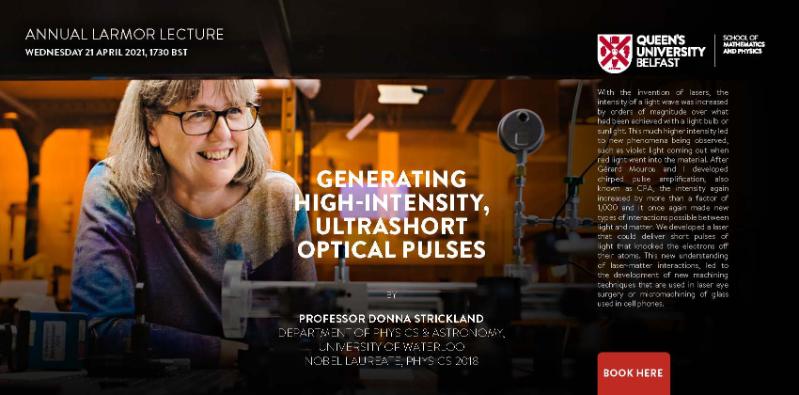This is a Free Online Public Lecture, hosted by the School of Mathematics and Physics, Queen’s University Belfast in partnership with Professor Donna Strickland.
- Date(s)
- April 21, 2021
- Location
- Online
- Time
- 17:30 - 19:00
- Price
- Free
“Generating High-Intensity, Ultrashort Optical Pulses”
Date: Wednesday 21 April 2021
Time: 17:30
Duration: Approximately 1 hour lecture followed by 30 minutes of Q&A
by
Professor Donna Strickland, FRS CC, Nobel Laureate Physics 2018
Professor Donna Strickland is a Professor in the Department of Physics and Astronomy at the University of Waterloo and is one of the recipients of the Nobel Prize in Physics 2018 for developing chirped pulse amplification with Gérard Mourou, her PhD supervisor at the time. They published this Nobel-winning research in 1985 when Strickland was a PhD student at the University of Rochester.
Strickland earned a B.Eng. from McMaster University and a PhD in optics from the University of Rochester. Strickland was a research associate at the National Research Council Canada, a physicist at Lawrence Livermore National Laboratory and a member of technical staff at Princeton University. In 1997, she joined the University of Waterloo, where her ultrafast laser group develops high-intensity laser systems for nonlinear optics investigations.
Strickland served as the president of the Optical Society (OSA) in 2013 and is a fellow of OSA, SPIE, the Royal Society of Canada and the Royal Society. She is an honorary fellow of the Canadian Academy of Engineering and the Institute of Physics and an international member of the US National Academy of Science. Strickland was named a Companion of the Order of Canada.
Abstract
With the invention of lasers, the intensity of a light wave was increased by orders of magnitude over what had been achieved with a light bulb or sunlight. This much higher intensity led to new phenomena being observed, such as violet light coming out when red light went into the material. After Gérard Mourou and I developed chirped pulse amplification, also known as CPA, the intensity again increased by more than a factor of 1,000 and it once again made new types of interactions possible between light and matter. We developed a laser that could deliver short pulses of light that knocked the electrons off their atoms. This new understanding of laser-matter interactions, led to the development of new machining techniques that are used in laser eye surgery or micromachining of glass used in cell phones.
Recording of Professor Strickland’s lecture is not permitted.
- Department
- School of Mathematics and Physics
- Add to calendar
| Name | School of Mathematics and Physics |
| mp@qub.ac.uk |
